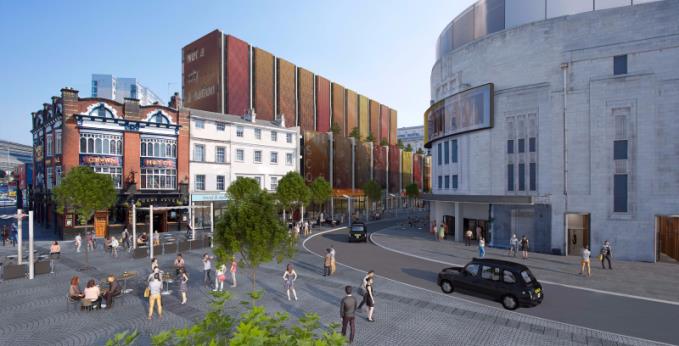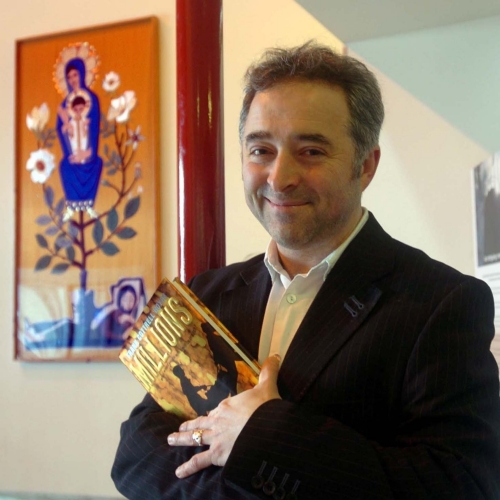INTERNATIONAL award-winning screen writer Frank Cottrell Boyce used Back to the Future day to join the fight to save one of the city's screen gems, the Futurist.
His intervention came as a legal challenge was launched to save the doomed picture house.
Rainhill-born Cottrell-Boyce, who wrote the 2012 London Olympics opening ceremony, visited the Futurist yesterday, 21 October 2015, celebrated as the date on which the heroes of the movie classic Back to the Future 2 are propelled forward in time from 1985.
He said: "This cinema is called the Futurist because it once represented the future when Liverpool led the world. I saw 2001: A Space Odyssey as a kid at the Futurist, which was full of visions of an amazing future.
“I still feel Liverpool's future could be different and amazing, and does not have to be about knocking down our historic buildings and putting up off-the-shelf student accommodation.
"Instead the Futurist could show the imaginative use of our heritage. It would be great to see its fine French Renaissance interior restored for use not just as a commercial cinema, but in an interesting and different way as a cinematic exhibition space for, say, I-Max or 3-D special features. Some of these could be aimed at visitors to tell Liverpool's story in a spectacular way.
"There's a future for these niche cinemas as seen in New York and Berlin. So why not make the Futurist into the UK's leader and put Liverpool ahead of the game again?”
 Going down, but not without a legal fight
Going down, but not without a legal fightThe legal challenge has been launched by London-based campaign group SAVE Britain’s Heritage. It has served proceedings on Liverpool City Council to judicially review its decision, taken in August this year, to demolish what it calls an “important run of Georgian, Victorian and Edwardian buildings along Lime Street”, including the 1912 Futurist, Liverpool’s oldest cinema and one of a diminishing number of pre-WWI movie theatres in the UK.
It says Liverpool Council failed to consult with either UNESCO or the Department for Culture, Media and Sport regarding the impact on the World Heritage Site. The north part of Lime Street is in the World Heritage Site, while the south part lies in the buffer zone.
In a statement SAVE said: "Liverpool Mayor Joe Anderson himself turned down the first design from architects Broadway-Malyan in March, saying that it was ‘not very impressive’. The second attempt continued to propose demolition of almost the entire historic frontage between the listed Crown and Vines pubs, and has been condemned by local and national architectural and heritage bodies. SAVE considers that more creative options can be explored to decide the fate of one of Liverpool’s most important streets."
READ: Exclusive: We reveal Lime Street like you've never seen it before
It added: “The present scheme exceeds the height restrictions in the buffer zone and, it is considered by objectors, who include Merseyside Civic Society, the Victorian Society, the Cinema and Theatres Association and respected local figures such as Florence Gerstein of Save Our City, that the design is obtrusive, heavy, and inappropriate for such a historically important and carefully planned area of Liverpool. The area abounds in listed buildings, including Lime Street Station, and St. George's Hall, both part of William Brown Street conservation area.
SAVE is an independent body which was founded in 1975 by a group of planners, journalists and architects to "speak out for the historic environment".
Its director, Clem Cecil, said Lime Street was "a gateway street of great value and significance," adding: "This has the potential to be a fantastic working street with strong economic impact. There is scope for building on the back of the site, but there is no need to destroy the entire block.”
 This is what is seriously being proposed for Lime Street
This is what is seriously being proposed for Lime StreetThe group has offered to mediate with Liverpool City Council, with its president, Marcus Binney, adding: "With a little more effort this can be a win win situation.”
Architect Trevor Skempton, a member of Liverpool's World Heritage Site Steering Group, echoed the calls for a more imaginative scheme and condemned the present plans drawn up by Neptune Develeopments.
“The historic facades incorporate aspects of communal memory and a varied texture which relates to the human scale of the street," he explained. "If this potent character is to be lost, this should only be accepted if something much better is to replace it. The proposal shows a monolithic structure. Repeated bays of equal width and similar texture do not have the same effect as the varied existing façades – it’s a mistake that’s been repeated many times in historic English cities – the grain is made coarser, and subtlety and interest disappear... Faced with this, conservation of the historic buildings seems to be the most logical way.”
 Frank Cottrell Boyce
Frank Cottrell BoyceSkempton went on: “The WHS and buffer zone include most of the city centre. There is no other WHS like it. Comparable areas like The Bund in Shanghai and Lower Manhattan do not face the restrictions of being World Heritage Sites. But, Liverpool, like them, has to breathe and grow – conserving the historic fabric and the spirit of the place as an integral part of its future...we should be ensuring that all developments within the WHS and its buffer zone are either exemplary in conservation terms or outstanding examples of modern design, representative of the progressive spirit of Liverpool.”
Aside from sharing the name with Liverpool’s only surviving intercity rail station, Lime Street is one of Liverpool’s most famous streets – enshrined in the folk-song Maggie May, recorded on the Beatles Let It Be album and a West End hit for Judy Garland. The 1960s and Alun Owen’s TV play, No Trams to Lime Street'.
The Futurist was constructed by renowned theatre architects Chadwick and Watson. It has a highly decorative façade of faience tiles. It has been claimed that it is beyond repair, but an engineering report carried out in February by independent civil and structural engineers Sutcliffe’s stated that the ‘external façade was found to be in reasonable condition’.
In March this year Baltic Triangle based architects 'We Make Places' worked with a group of local designers to come up with a widely praised alternative vision for Lime Street, retaining the facade of the Futurist as a winter garden to connect the historic street front with the new development.
Jonathan Brown, a planning consultant and Merseyside Civic Society council member says: “This is a golden opportunity to deliver a first-rate future for Lime Street. Neptune should be able to offer Liverpool a better balance of new buildings and restoration on this most important city gateway, as they did in their excellent redevelopment of the art-deco airport in Speke.
"I hope the offer of mediation is embraced by the Council to encourage the developer’s architects to come up with a more sensitive and sophisticated scheme.”
Further reading: Lullaby of Lime Street














